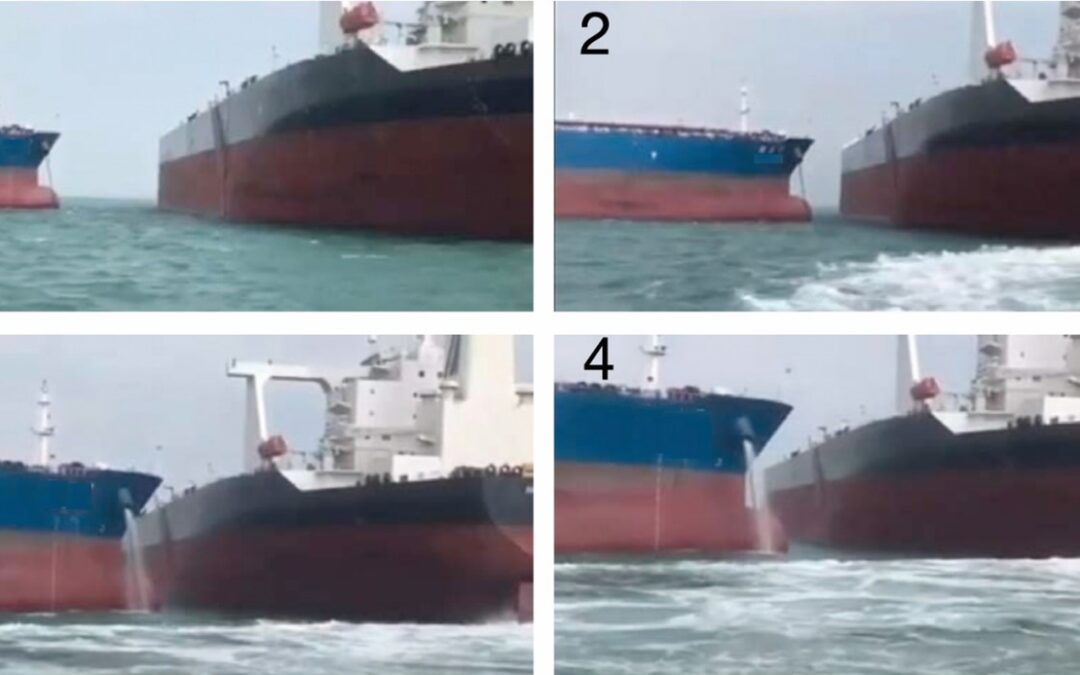Effective bridge resource management (BRM) should be a working culture, a safety habit that is embraced and practiced by all navigating officers, says The Nautical Institute. Its latest Mars report provides an example of how not to do it. In it, a VLCC collided with a buoy and almost hit an anchored vessel as well.
The Nautical Institute gathers reports of maritime accidents and near-misses. It then publishes these so-called Mars Reports (anonymously) to prevent other accidents from happening. A summary of this incident:
A VLCC in ballast was approaching port for anchoring. The pilot was confirmed for 10:00. Weather conditions were good with a northerly wind of about 10 knots, good visibility and slight sea conditions. A tidal stream was running in the WSW direction at about 1.8 knots. The engine was put to dead slow ahead to drop off speed and adjust vessel’s arrival at the pilot boarding area for the prearranged time.
At 09:37, the master asked the officer of the watch (OOW) if he had established a visual contact with the pilot boat. The OOW responded positively. The bridge team was confident that the pilot boat would be at the designated position before their vessel, so no action to further slow or stop the vessel was taken. Several minutes later, with the vessel steering 300 degrees and with a speed of 5.8 knots, the remaining distance to the pilot station was about 1.2 nm.
At 09:50, the vessel was heading 315 degrees at a speed of about 5.3 knots and the distance from the pilot station was now only about 0.7 nm. The master stopped the engine. The vessel continued to slow and the heading now increased slowly to starboard. The vessel was closing on a buoy.
Also read: Not challenging the pilot leads to passenger vessel grounding
At 10:00 the speed was about 4 knots and the pilot boat had not yet arrived. The master ordered hard starboard and set the main engine to dead slow ahead in order to avoid the buoy, but to no avail; they struck the buoy about four minutes later on the port side near midships. The buoy slid down the vessel’s port side and cleared the stern with only minor damage.
But now, as the vessel drifted with a speed over ground (SOG) of 3.4 knots, their trajectory was towards a nearby anchored vessel. The master attempted to stop the vessel, but the distance to the anchored vessel was now only 0.5 nm. The master quickly concluded that it was not feasible to stop the vessel. Instead, by putting “Full Ahead” on the engine in combination with a succession of wheel alterations (hard to starboard and then hard to port) they managed to avoid contact with the anchored vessel.
About twenty minutes later, the pilot boarded and subsequently safely anchored the vessel in the anchorage area.
Also read: Tug order mix-up leads to allision and shore crane collapse
Company findings
The company report found, among others that:
- The passage plan lacked the appropriate precautions and contingency arrangements. Specifically, the speed of approach and the waiting area for the approach were not adequately planned.
- The large drift angle and the proximity of navigational hazards was not determined at an early stage.
- The current’s effect on vessel’s drift was not effectively monitored and assessed. As result, the bridge team did not adjust the vessel’s course and speed in a timely manner while approaching the pilot boarding station.
- Bridge resource management (BRM) was less than adequate. The master did not explicitly inform the ship’s bridge team about his intentions related to approaching and manoeuvring. As the ship progressed, the OOW’s comprehension of the situation did not trigger any actions for clarification or corrective action.
- The OOW did not provide sufficient information related to the pilot boat approaching. Instead, he confirmed that the pilot boat was approaching without informing the master of the actual distance from the vessel and the required time to arrive alongside. As a result, the master wrongly assumed that the pilot boat was closer than it actually was, so he continued on instead of stopping.
Advice from The Nautical Institute
In addition to the advice published above The Nautical Institute says that closed-loop communications should always be used to eliminate any doubt or ambiguity.
Also read: Disoriented master leads to ferry colliding with sailing yacht
Mars Reports
This accident was covered in the Mars Reports, originally published as Mars 202240, that are part of Report Number 359. A selection of this Mars Report was also published in SWZ|Maritime’s October 2022 issue. The Nautical Institute compiles these reports to help prevent maritime accidents. That is why they are also published (in full) on SWZ|Maritime’s website.
More reports are needed to keep the scheme interesting and informative. All reports are read only by the Mars coordinator and are treated in the strictest confidence. To submit a report, please use the Mars report form.








